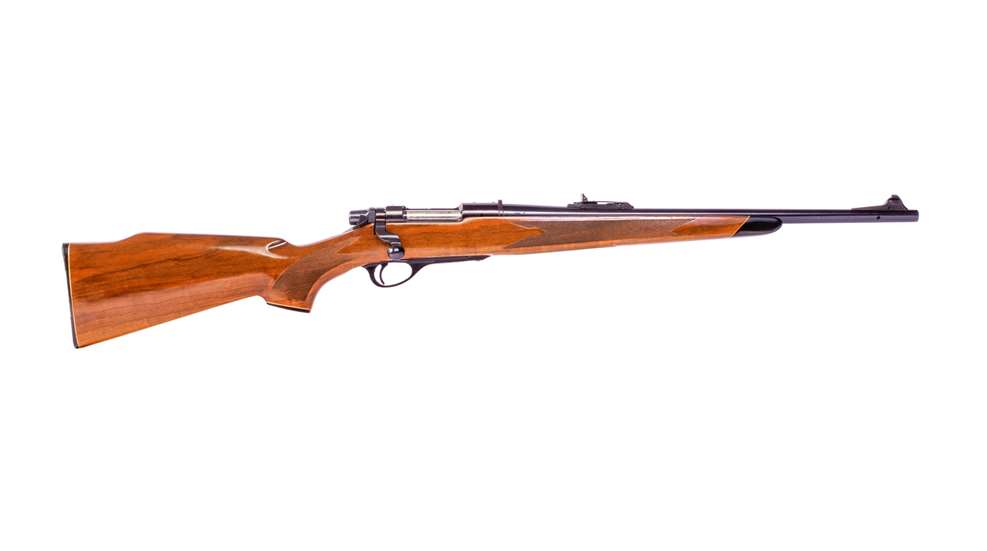
The post-World War II era was a time of change in the sporting rifle world. Not only were domestic companies competing with surplus military rifles, many of which came home in the duffle bags of returning servicemen, they also faced the postwar economic realities that drove up the price of firearms that required extensive machining and hand-fitting. In 1948, Remington introduced the Models 721 and 722, predecessors to the famous Model 700 the company unveiled in 1962. The Model 700 ushered in a new era of sporting bolt-action rifles where modern technology and materials would be used to produce economical firearms that were accurate and durable. The 700 would inspire other innovative Remington products, including a bolt-action version of the compact and lightweight saddle guns that Americans were so fond of.
The Remington Model 600, introduced in 1963, was a visually distinctive rifle, with a nylon shotgun-style vent rib on its barrel and a dogleg bolt handle that hearkened back to the Model 1917 military rifle that Remington manufactured for World War I, as well as the company’s Model 30 sporting rifles (the company called it the “forward S” bolt handle). Using a push-feed “three rings of steel” short action (the single-shot Remington XP-100 pistol, introduced a year earlier, used a similar action), Remington chambered the rifle in compact cartridges such as the .243 Win. and .308 Win. A lightweight, 18.5" barrel was used, and the barreled action was placed in a checkered walnut Monte Carlo-style stock.
The Model 600 had an overall length of 37.25", weighed 5 lbs., 8 ozs., and cost $99.95. In advertising the rifle, Remington asked the rhetorical question “How do you make a carbine that pound for pound, hits harder, shoots straighter than anything in its class?” This was a not-so-subtle dig at the company’s lever-action competitors, declaring that the Model 600 “carries like a carbine, points like a shotgun, and shoots like a rifle.”
The Model 600 was discontinued in 1967 and replaced the following year with the Model 660. Using the same basic action as the 600, the 660 came standard with a slightly longer 20" barrel that discarded the vent rib. A few other visual elements differed, like its blued bolt handle and black polymer fore-end tip and grip cap with a white-line spacer. Beyond this, the rifle was nearly identical, with an overall length exactly 1.5" longer and weighing a pound more. The price also increased by $20.
The Remington Model 660 was chambered in .222 Rem., .223 Rem., 6 mm Rem., .243 Win. and .308 Win. Like the 600, a magnum model was offered in Remington’s proprietary belted short-action magnum cartridges, the 6.5 Rem. Mag. and .350 Rem. Mag., that had a stock of walnut and beech laminate with a rubber recoil pad and cost $30 more. As with its predecessor, the .223 Rem. chambering is the rarest, with only 227 Model 660s manufactured for that cartridge. Rifles chambered in .222 Rem. will also bring a slight premium, along with magnum models.
The Model 660’s production run lasted from 1968-1971, with a total of 50,536 manufactured. At that point, Remington introduced the Model 600 Mohawk, which reverted to the 18.5" barrel, but without the vent rib; it was produced until 1979. The influence of the Model 600 series of rifles would live on beyond their production run. Colonel Jeff Cooper would use a Model 600 as the basis of a scout rifle prototype, and the design serves as an inspiration for scout- and guide-style bolt-action rifles up to this day. The Remington Model 660 pictured is chambered in .308 Win. and was manufactured in March of 1969. It is in NRA Good condition and is valued at $750.

Gun: Model 660
Manufacturer: Remington
Chambering: .308 Win.
Manufactured: 1969
Condition: NRA Good (Modern Gun Standards)
Value: $750





































